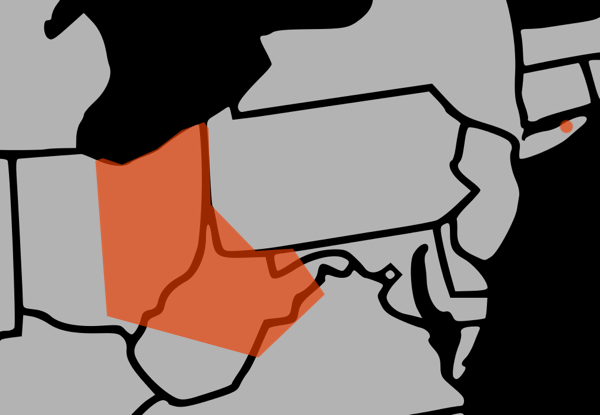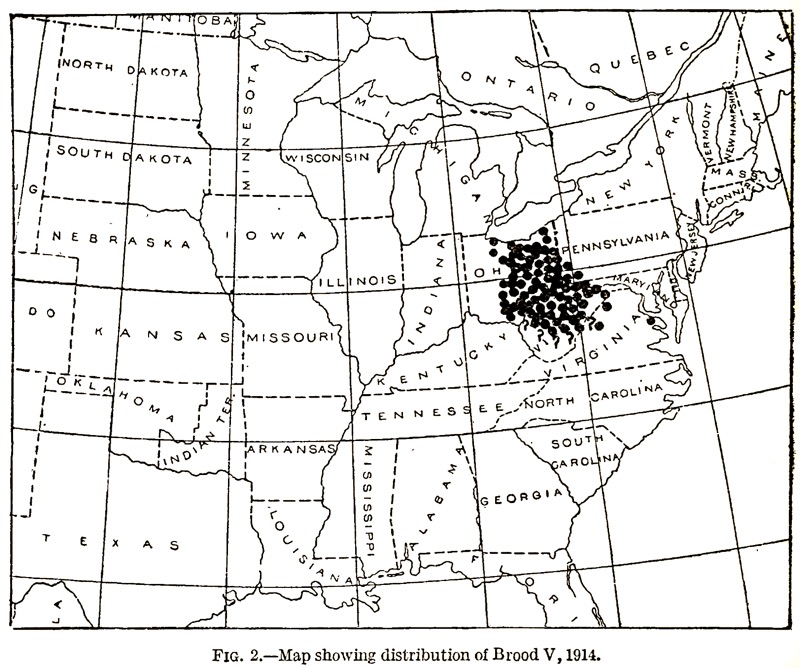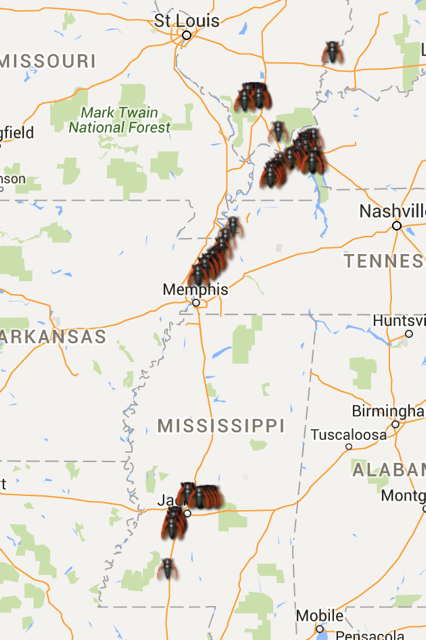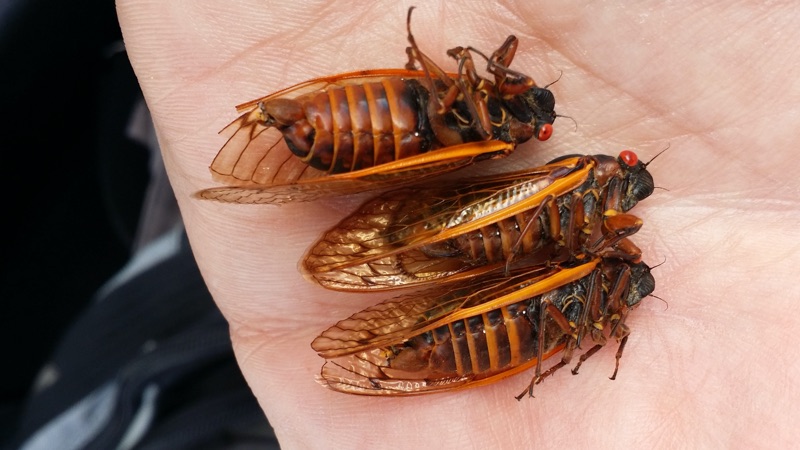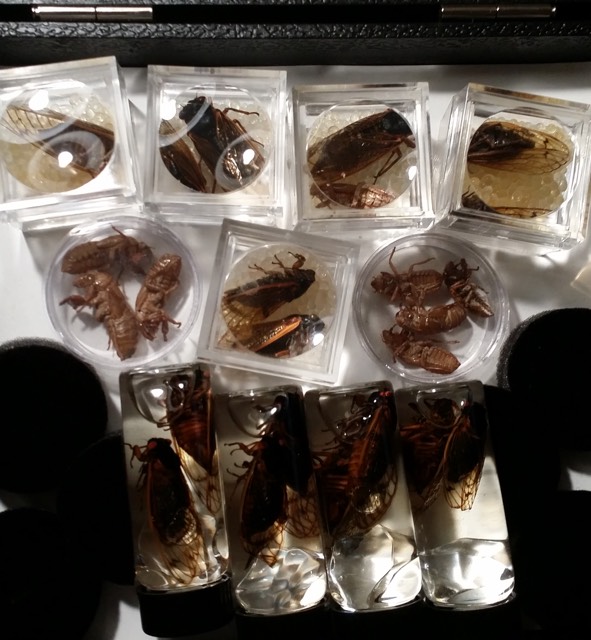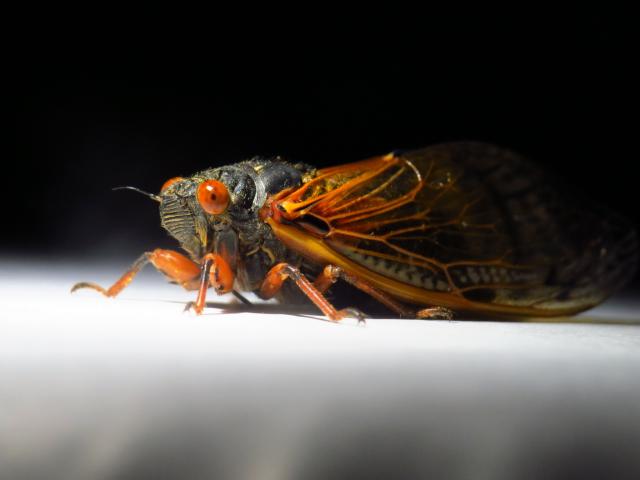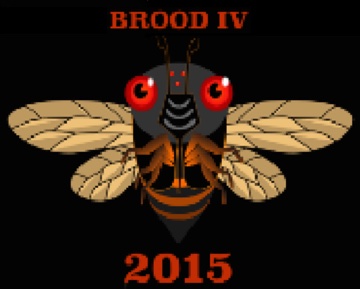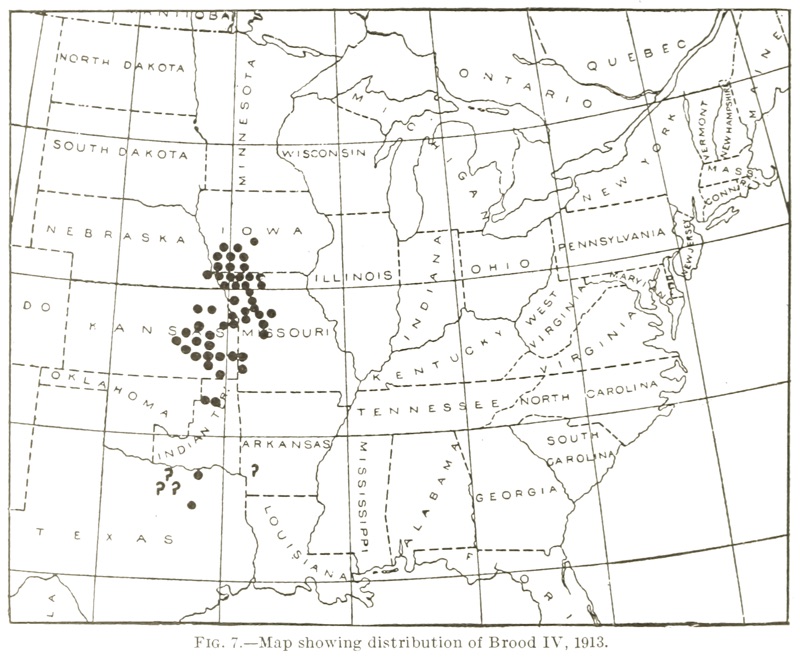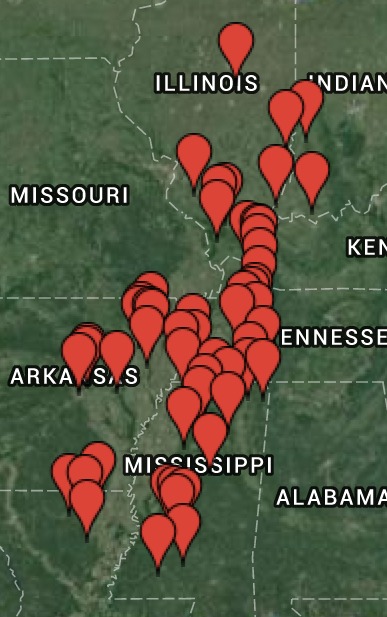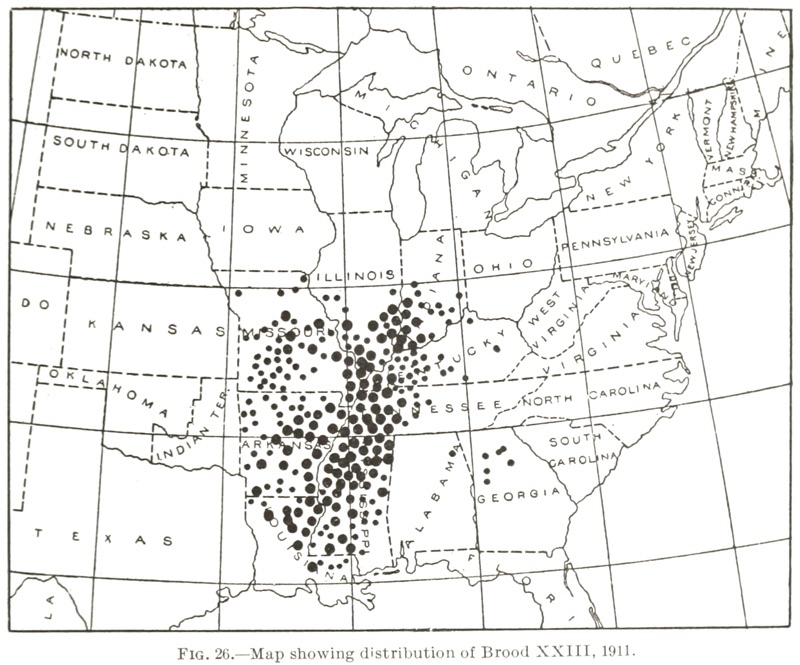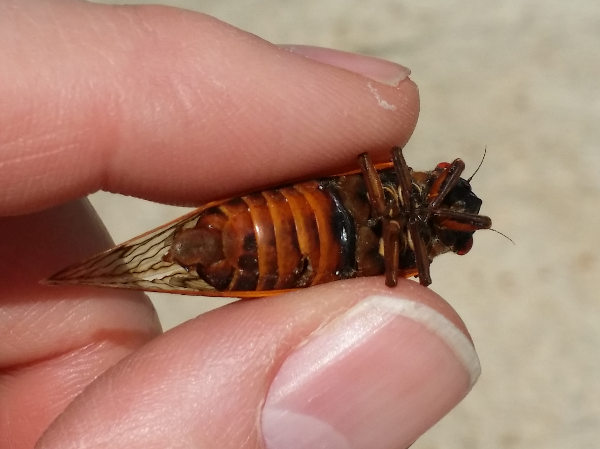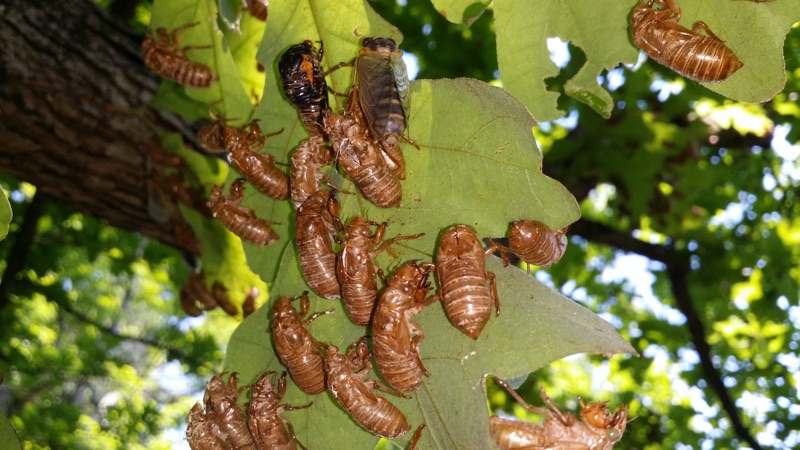
Many exuvia clinging to oak leaves. Core Arboretum, WVU.
My plan was to check out Maryland first, then head to West Virginia for a few days, and then Ohio. If weather, time and patience allowed, Virginia and Long Island, New York. Like all my periodical cicada trips I start by consulting the map on Cicadas @ UCONN (formerly Magicicada.org) to see where folks are finding cicadas. I also consult with the folks who study periodical cicadas professionally to discover their favorite hot spots and any locations of particular scientific interest. This year, the interesting spot was north-western Maryland — more on that later.
Generally speaking, you’ll see a lot of pin-drops for Magicicada cassini on the map. This is because you can hear them while driving at 70mph. You often have to stop your car and turn off the engine to hear the other species, so even though there’s lots of M. cassini on the map, there’s probably just as much M. septendecim. Generally speaking, my mapping methodology works like this: I stop and take notes when I can (usually at rest stops, parks or when I’m staying in a particular town — see Morgantown & Athens later in the article) and this is when I’ll hear M. septendecim & M. septendecula, but when I’m driving interstate highways at high speeds (with a parade of angry drivers who would rather tailgate me that use the left lane to go around me) I can only take data points for M. cassini.
What do I bring with me on a seven-day cicada road trip? Aside from clothes, road food, smartphone, and my AAA card, I bring equipment to aide my study of cicadas:
- A junk computer. A decrepit laptop that I won’t care if it gets stolen.
- A video camera.
- A device for measuring sound level (decibels).
- A notepad and pen (because technology fails).
- Butterfly pavilions, which are these expandable enclosures for holding and observing insects.
- Containers for holding dead specimens, and silica gel to keep them dry. Note: before you collect, make sure it is legal in the location you plan to collect. Collecting wildlife from National Parks is illegal. Collecting cicadas from a Hampton Inn parking lot is usually okay.
- Suntan lotion and Bug Spray. I like insects, but ticks and mosquitos can turn cicada observation into a nightmare. Many researchers wear pyrethrum treated clothes (yes, bad for cats).
- A flashlight.
- Cicada Mania pins for folks I meet along the way.
What I don’t bring but should is one of John Cooley’s Cicada O Matic GPS Dataloggers. I have to make observations by hand.
Other than that, I follow the typical Power Vacation rules.
Maryland Part 1:
The first town I hit was Accident, Maryland (great name). There were sightings on the Cicadas @ UCONN map, and the name of the town was awesome, so I wanted to check it out. Unfortunately, I didn’t observe any cicadas there.
Route 68, West Virginia
Traveling west along Route 68, about half-way between the center of Bruceton Mills and Coopers Rock State Forest I started to hear pockets of M. cassini. I stopped at Coopers Rock, and at first, I was disappointed: I didn’t hear any cicadas from my car. Once I stopped my car and turned off the engine I could hear them: M. septendecim with their spooky sci-fi UFO chorus in the distance. It became obvious that the park had a healthy population of M. septendecim, with a smattering of M. cassini as well.
Morgantown, WV
Next, I arrived at Morgantown, WV. Some twitter friends had been posting cicada photos from there, so I thought it would be a good location to set up base and make observations for a few days. The hotel I chose had an excellent population of M. septedecim and cassini around it; so much so that the staff couldn’t keep up with unwanted cicada guests that littered their doorway, trampled by oblivious human guests.
My first day there I walked around the West Virginia University campus near the hospital, stadium & iHop. The sky was overcast and it was getting late in the afternoon, but it was clear that the campus and town had an abundance of periodical cicadas, and that I made a good choice in setting up camp there. At night, in my hotel parking lot, I was able to watch cicadas emerge as nymphs as transform into adults, which is always a highlight of an emergence for me.
WVU Core Arboretum
Core Arboretum is a large botanical garden devoted to trees (“arbor”) on the WVU campus. It was an excellent place to observe cicadas. I was able to observe all three species, the tiny but LOUD M. cassini, the larger & relatively docile M. septendecim, and the rarest of the species M. septendecula. Finding M. septendecula so early in my trip was a treat. Their clockwork/tambourine sound (at least that’s what I think they sound like) gave them away.
I met entomologists Matt Berger, who has contributed many cicada photos to this site over the years, and his colleague HereBeSpiders11 (twitter name). Awesome people. I met Zachariah Fowler, the director of the arboretum as well. Another awesome person.
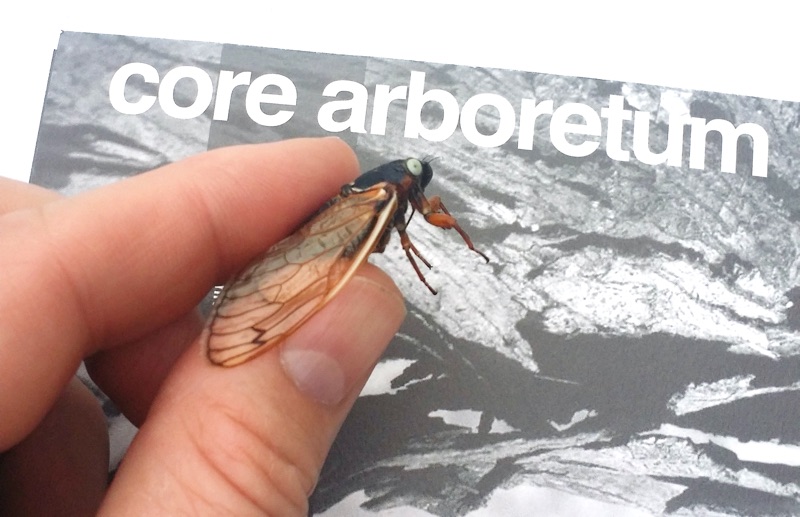
A white-eyed Magicicada septendecim.
I was able to check off many of my cicada checklist items in Morgantown: I found a white-eyed cicada, I saw & heard all three species, and more.
Leaving West Virginia, Entering Ohio
M. cassini were plentiful along route 79 and 50 headed west towards Athens, Ohio. Along the way, I made a few stops and heard & observed some M. septendecim as well.
Athens, Ohio
Athens was another good location to stay and observe cicadas. The parks in the surrounding area had excellent cicada populations, and I had a rare chance to meet John Cooley of Cicadas @ UCONN (formerly Magicicada.org).
My first day in Athens I spent at Dow Lake in Strouds Run State Park. There I met John Cooley who was there showing a German film crew the particulars of cicada behavior. Dow Lake had a healthy mix of LOUD M. cassini and M. septendecim, but the cassini definitely dominated. The highlight for me was not a cicada, but spotting a rat snake climbing down from an acacia tree where it was no-doubt snacking on cicadas.
Sells Park in Athens was a nice place to hear VERY LOUD M. cassini choruses, well into the high 80-90db mark. So loud that I limited my time there, and left after an hour.
Hocking Hills
Hocking Hills is an amazing park north of Athens than features a spectacular above-ground cave and many acres of forest filled with cicadas. Hocking Hills had a good population of all three species, and M. septendecula were unusually easy to find. They seem to have preferred areas where deciduous trees blended with evergreens, at least in the locations I found.
Vinton Furnace Experimental Forest
A Magicicada cassini chorus from the Experimental Forest:
A Magicicada chorus with audible M. septendecula from the Experimental Forest:
Vinton Furnace Experimental Forest is a forest curated to include as much biological diversity as possible. All three periodical cicada species make up part of that diversity. M. septendcula choruses were very easy to find. The forest was thrilling to visit — aside from the biting deer flies, it was exhilarating to see or hear so many species of insects, birds, and plants in one place. Also, thrilling were the winding one-lane dirt roads; I almost died a few times thanks to wild drivers out for a pretend Finland Rally race.
Back to Maryland
After an overnight stop back in Morgantown, WV, I headed back to Maryland to prove (or disprove) that periodical cicadas were there, and if I did find them, the extent of their population. It is important to show the limits of their population as researchers (John Cooley in particular) are interested in demonstrating that the Brood V population in Ohio, Pennsylvania, West Virginia & Maryland is distinct from the population in Virginia.
I’m happy to report that I did find periodical cicadas in Maryland. The populations were mostly the relatively quieter M. septendecim — the type you really have to stop the car & turn off the engine to be certain they’re there. I did find M. cassini as well, but M. septendecim dominated. The adorably named Friendsville and Selbysport had good populations, as did the hill above the Youghiogheny river overlook rest stop on I68. South of this area, I did not hear or see cicadas on Bear Creek Road, Rt 42, Rt 219 or Rt 495. It is possible there are pockets of cicadas deep in the woods and out of earshot in those areas, but it is clear there was no great population of periodical cicadas in those areas if any at all. I spoke to a chainsaw bear sculptor in Bittinger, which is not far from where the Appalachian Plateau ends & the Ridge and Valley area starts. I showed him a photo of a periodical cicada. He said he had never seen them in his life, and nor did he see them in Accident where he went to church. He did hear about them on the news, so he was aware of them.
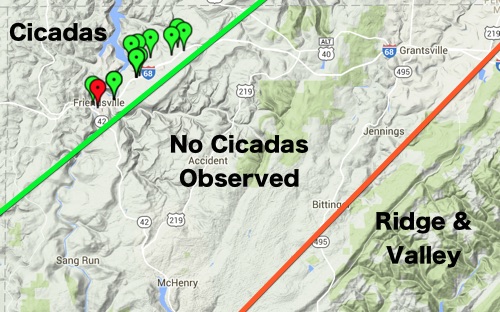
Pennsylvania, and home
After collecting cicada data and buying a chainsaw bear, I headed north into Pennsylvania. I stopped at a rest stop, enjoyed the last I would hear of Brood V, and headed back home.
More!
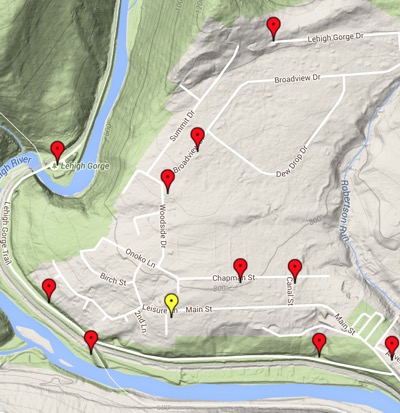
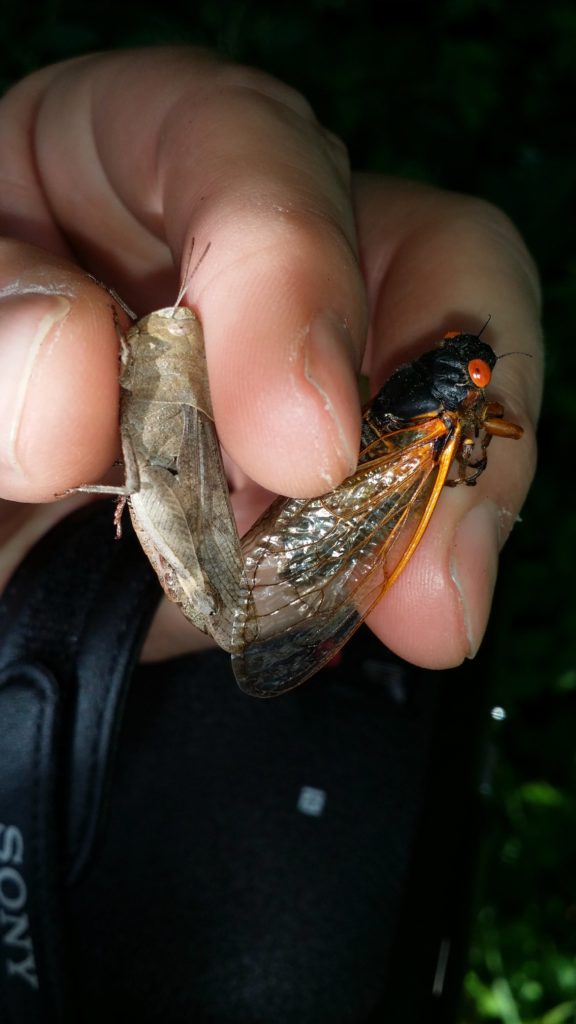


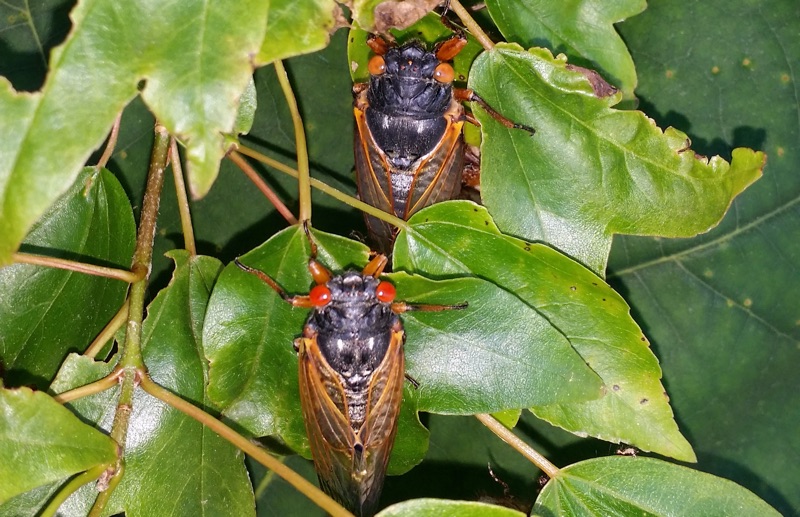
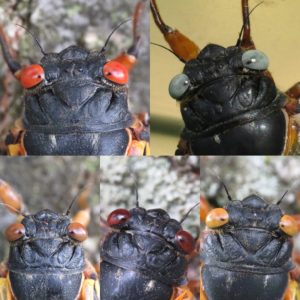
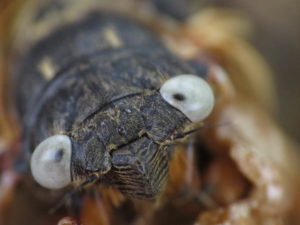
 Brood V (5) 17-year cicadas have emerged, this spring of 2016, in Maryland, New York, Ohio, Pennsylvania, Virginia & West Virginia.
Brood V (5) 17-year cicadas have emerged, this spring of 2016, in Maryland, New York, Ohio, Pennsylvania, Virginia & West Virginia. 